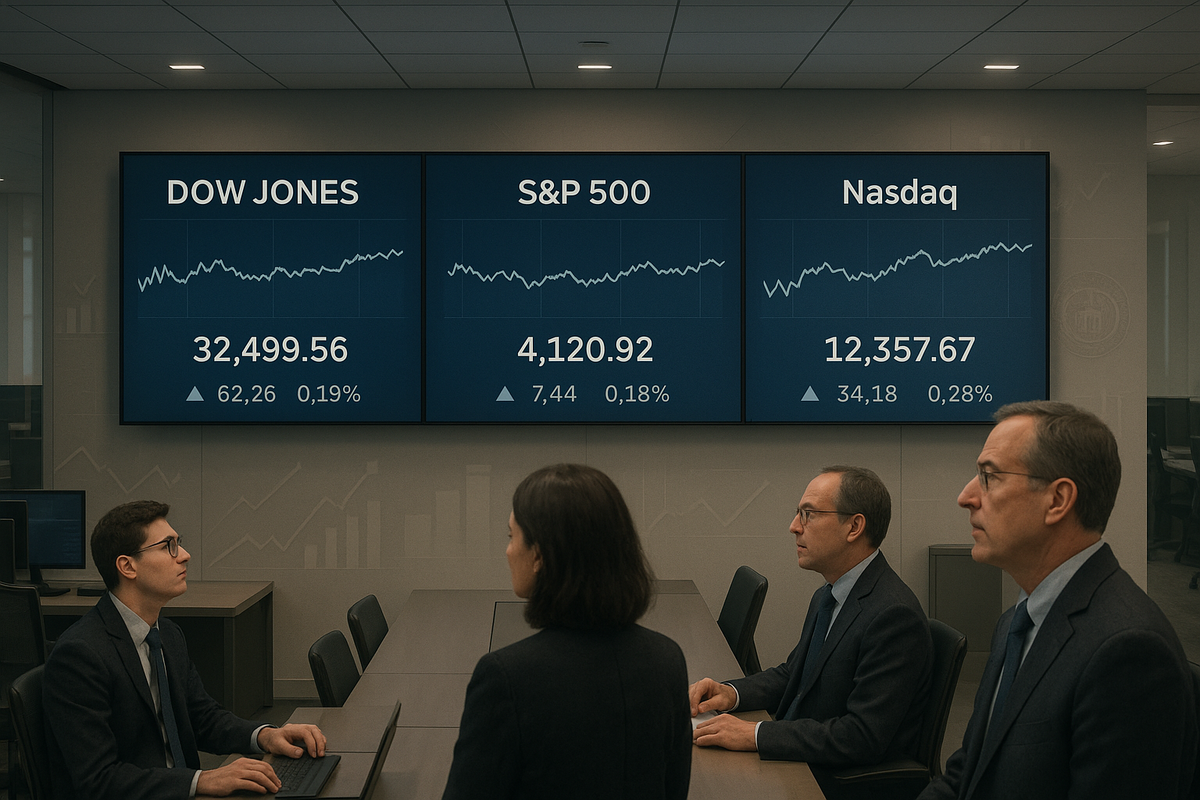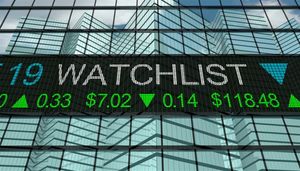
Despite hovering at or near all-time highs, the major U.S. stock indices—the Dow Jones Industrial Average, S&P 500, and Nasdaq Composite—have recently displayed a remarkably subdued daily performance. This period of consolidation, marked by narrow trading ranges and fractional movements, signals a market grappling with a blend of cautious optimism and underlying anxiety. Investors appear to be in a "wait-and-see" mode, digesting mixed economic signals and anticipating crucial policy cues, rather than pushing equities decisively higher.
The immediate implication of this cautious trading is a market in a holding pattern, where significant directional moves are on pause. This consolidation phase suggests that while the bullish sentiment remains, fueled by expectations of potential Federal Reserve easing, there's a palpable reluctance among investors to commit further capital without clearer catalysts. This delicate balance sets the stage for potential volatility, as any unexpected news, particularly from central bank communications, could trigger a more pronounced market reaction.
The Quiet Grind: What's Behind the Market's Hesitation?
The current subdued performance of the U.S. stock market, even as indices flirt with record highs, is a testament to a complex interplay of factors. Over recent weeks, daily movements in the S&P 500 (^GSPC), Nasdaq Composite (^IXIC), and Dow Jones Industrial Average (^DJI) have been characterized by modest gains or slight declines, a stark contrast to the robust rallies that propelled them to their current elevated levels. For instance, recent trading days have seen the S&P 500 closing with fractional changes, extending a period of consolidation around its recent record. Similarly, the Nasdaq 100 has fluctuated around its own record high, often ending the day with minimal movement. The Dow, while also near its all-time peak, has mirrored this cautious sentiment with minor daily shifts.
This cautious trading environment is primarily driven by the market's intense focus on the Federal Reserve's monetary policy. Investors are keenly awaiting signals from Federal Reserve Chair Jerome Powell's upcoming speech at the annual Jackson Hole Symposium. The uncertainty surrounding the Fed's stance on interest rates, particularly the timing and pace of potential cuts, is a significant deterrent to aggressive buying. Many market participants are betting on a September rate cut, and any deviation from a sufficiently "dovish" message from Powell could trigger a significant market reaction. This anticipation has led to a collective "wait-and-see" approach among institutional and retail investors alike.
Adding to the market's hesitation are mixed economic data points. While some inflation readings have come in cooler than anticipated, other indicators, such as surprisingly high producer price index (PPI) figures and a dip in consumer sentiment due to inflation fears, paint a less clear picture. The labor market, while generally robust, has also shown some signs of softening, with a recent nonfarm payrolls report indicating the weakest three-month average since 2010. This "awkward" economic backdrop complicates the Fed's dual mandate of price stability and maximum employment, further fueling investor uncertainty. Geopolitical tensions, including ongoing discussions around the Ukraine-Russia crisis and expanded U.S. tariffs, also contribute to the cautious sentiment, keeping markets within narrow trading ranges.
Navigating the Crosscurrents: Potential Winners and Losers
In this environment of cautious consolidation, the market is witnessing a subtle but significant shift in investor preferences, creating potential winners and losers across various sectors. The strong rally that propelled the major indices to their current highs was largely driven by mega-cap technology stocks. However, as uncertainty regarding interest rates and economic growth persists, some investors are beginning to rotate away from these high-growth names towards more defensive plays.
Companies in sectors traditionally considered defensive, such such as industrials and healthcare, could emerge as relative winners. These sectors often provide more stable earnings and dividends, making them attractive during periods of market uncertainty or when investors anticipate an economic slowdown. For example, large-cap industrial companies like General Electric (NYSE: GE) or healthcare giants such as Johnson & Johnson (NYSE: JNJ) might see increased investor interest as capital flows out of more speculative growth stocks. Their established business models and less cyclical nature offer a perceived safe haven.
Conversely, the high-flying technology sector, which has been a primary driver of the recent bull run, could face headwinds. While companies like Apple (NASDAQ: AAPL), Microsoft (NASDAQ: MSFT), and NVIDIA (NASDAQ: NVDA) have demonstrated exceptional growth, their lofty valuations make them particularly vulnerable to any negative surprises, especially regarding interest rate expectations. A more hawkish stance from the Federal Reserve or a significant slowdown in consumer spending could lead to profit-taking and a re-evaluation of their growth prospects. Investors might become more discerning, favoring tech companies with strong free cash flow and sustainable business models over those with high valuations based purely on future growth potential. This rotation suggests that while the overall market might remain elevated, the leadership within it could shift, impacting the performance of individual companies and sector-specific exchange-traded funds (ETFs).
Broader Implications and Industry Ripple Effects
The current subdued market performance, despite being near record highs, fits into a broader trend of market maturity following a significant rally. This period of consolidation is not uncommon after extended periods of growth, as investors pause to reassess valuations and future catalysts. The S&P 500's trailing earnings per share multiple, noted as being among the highest since the year 2000, underscores concerns about lofty valuations, making the market more susceptible to negative news or a shift in monetary policy expectations.
The ripple effects of this cautious sentiment extend across various industries. Companies heavily reliant on consumer discretionary spending, for instance, might face increased scrutiny if consumer sentiment continues to deteriorate due to inflation fears. Conversely, sectors that benefit from stable demand, such as utilities or consumer staples, could see sustained interest. Regulatory or policy implications also loom large; any new tariffs or trade restrictions, as seen in ongoing discussions around global trade, could impact multinational corporations and supply chains, adding another layer of uncertainty. Historically, periods of high valuation combined with central bank uncertainty have often preceded periods of increased volatility or corrections, serving as a cautionary tale for investors. The current environment, while not signaling an imminent crash, certainly echoes past periods where a "wait-and-see" approach eventually gave way to a more decisive market move, either up or down.
What Comes Next: Navigating the Path Forward
The immediate future of the market hinges significantly on the upcoming Federal Reserve Chair Jerome Powell's speech at Jackson Hole. A "dovish" message, signaling a clear path to interest rate cuts, could provide the necessary catalyst to push markets to new highs, potentially reigniting the rally in growth stocks. Conversely, a more hawkish tone, or even a lack of clear commitment to easing, could trigger a significant pullback, with some strategists warning of a potential 7% to 15% decline into October. This short-term uncertainty necessitates a flexible investment approach.
In the long term, the market's trajectory will be shaped by the interplay of inflation, economic growth, and corporate earnings. Should inflation continue to cool and economic growth remain resilient, it could pave the way for a sustained bull market, albeit with potentially lower returns than seen in the recent past. However, a resurgence of inflation or a deeper economic slowdown could lead to more challenging market conditions. Companies will need to adapt strategically, focusing on cost efficiencies, innovation, and resilient supply chains to navigate potential headwinds. Market opportunities may emerge in sectors that demonstrate strong fundamentals and are less sensitive to interest rate fluctuations, or in companies that are undervalued relative to their long-term growth prospects. Investors should prepare for potential scenarios ranging from a continued grind higher to a more significant correction, emphasizing diversification and risk management.
Conclusion: A Market at a Crossroads
The current subdued daily performance of the Dow Jones Industrial Average, S&P 500, and Nasdaq Composite, despite their proximity to record highs, underscores a market at a critical juncture. The key takeaway is a prevailing sense of caution and anticipation, driven primarily by uncertainty surrounding Federal Reserve policy and mixed economic signals. This period of consolidation reflects a market that has largely priced in anticipated rate cuts and now awaits concrete confirmation and new catalysts to determine its next significant move.
Moving forward, the market's direction will be heavily influenced by central bank communications, particularly from the Federal Reserve, and upcoming corporate earnings reports, especially from the retail sector, which will offer insights into consumer health. Investors should remain vigilant, paying close attention to inflation data, employment figures, and geopolitical developments. While the Cboe Volatility Index (VIX) has remained relatively subdued, suggesting a lack of immediate fear, the potential for a sharp reaction to unexpected news remains. Diversification, a focus on fundamentally strong companies, and a disciplined approach to risk management will be paramount in the coming months as the market navigates these crosscurrents and seeks its next direction.







